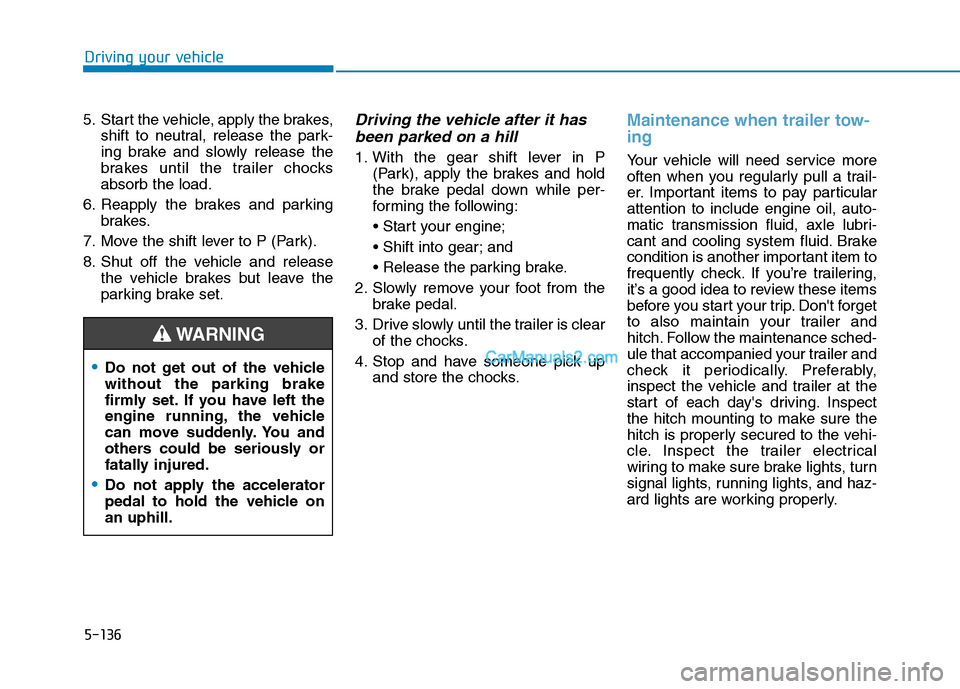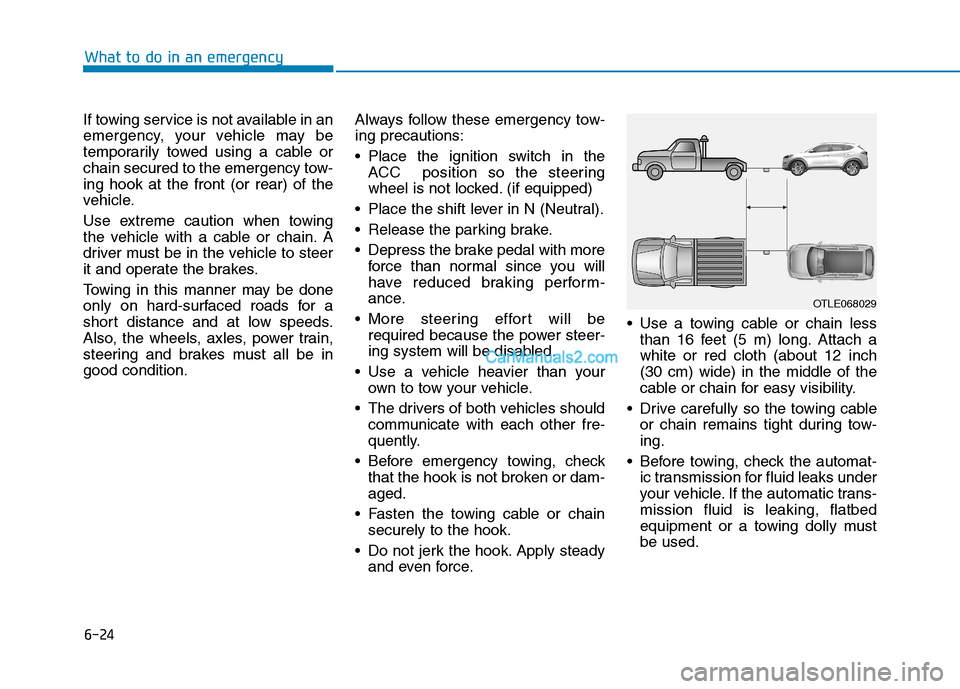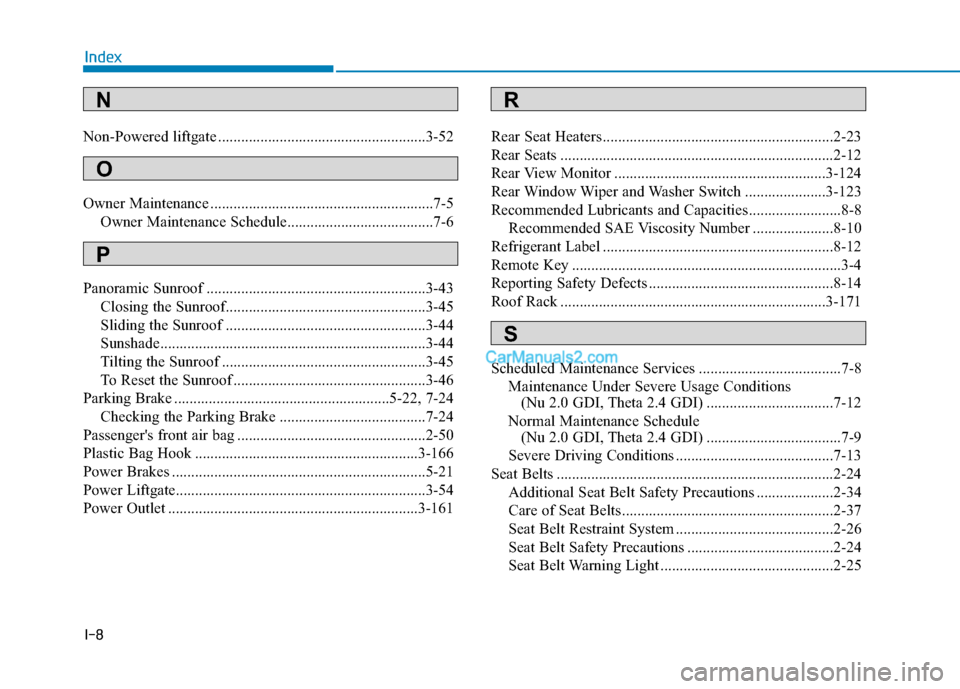Page 402 of 546

5-136
Driving your vehicle
5. Start the vehicle, apply the brakes,
shift to neutral, release the park-
ing brake and slowly release the
brakes until the trailer chocks
absorb the load.
6. Reapply the brakes and parking
brakes.
7. Move the shift lever to P (Park).
8. Shut off the vehicle and release
the vehicle brakes but leave the
parking brake set.
Driving the vehicle after it has
been parked on a hill
1. With the gear shift lever in P
(Park), apply the brakes and hold
the brake pedal down while per-
forming the following:
and
2. Slowly remove your foot from the
brake pedal.
3. Drive slowly until the trailer is clear
of the chocks.
4. Stop and have someone pick up
and store the chocks.
Maintenance when trailer tow-
ing
Your vehicle will need service more
often when you regularly pull a trail-
er. Important items to pay particular
attention to include engine oil, auto-
matic transmission fluid, axle lubri-
cant and cooling system fluid. Brake
condition is another important item to
frequently check. If you’re trailering,
it’s a good idea to review these items
before you start your trip. Don't forget
to also maintain your trailer and
hitch. Follow the maintenance sched-
ule that accompanied your trailer and
check it periodically. Preferably,
inspect the vehicle and trailer at the
start of each day's driving. Inspect
the hitch mounting to make sure the
hitch is properly secured to the vehi-
cle. Inspect the trailer electrical
wiring to make sure brake lights, turn
signal lights, running lights, and haz-
ard lights are working properly.
Do not get out of the vehicle
without the parking brake
firmly set. If you have left the
engine running, the vehicle
can move suddenly. You and
others could be seriously or
fatally injured.
Do not apply the accelerator
pedal to hold the vehicle on
an uphill.
WARNING
Page 433 of 546

6-24
What to do in an emergency
If towing service is not available in an
emergency, your vehicle may be
temporarily towed using a cable or
chain secured to the emergency tow-
ing hook at the front (or rear) of the
vehicle.
Use extreme caution when towing
the vehicle with a cable or chain. A
driver must be in the vehicle to steer
it and operate the brakes.
Towing in this manner may be done
only on hard-surfaced roads for a
short distance and at low speeds.
Also, the wheels, axles, power train,
steering and brakes must all be in
good condition.Always follow these emergency tow-
ing precautions:
Place the ignition switch in the
ACC position so the steering
wheel is not locked. (if equipped)
Place the shift lever in N (Neutral).
Release the parking brake.
Depress the brake pedal with more
force than normal since you will
have reduced braking perform-
ance.
More steering effort will be
required because the power steer-
ing system will be disabled.
Use a vehicle heavier than your
own to tow your vehicle.
The drivers of both vehicles should
communicate with each other fre-
quently.
Before emergency towing, check
that the hook is not broken or dam-
aged.
Fasten the towing cable or chain
securely to the hook.
Do not jerk the hook. Apply steady
and even force. Use a towing cable or chain less
than 16 feet (5 m) long. Attach a
white or red cloth (about 12 inch
(30 cm) wide) in the middle of the
cable or chain for easy visibility.
Drive carefully so the towing cable
or chain remains tight during tow-
ing.
Before towing, check the automat-
ic transmission for fluid leaks under
your vehicle. If the automatic trans-
mission fluid is leaking, flatbed
equipment or a towing dolly must
be used.
OTLE068029
Page 543 of 546

I-8
Non-Powered liftgate ......................................................3-52
Owner Maintenance ..........................................................7-5
Owner Maintenance Schedule......................................7-6
Panoramic Sunroof .........................................................3-43
Closing the Sunroof....................................................3-45
Sliding the Sunroof ....................................................3-44
Sunshade.....................................................................3-44
Tilting the Sunroof .....................................................3-45
To Reset the Sunroof ..................................................3-46
Parking Brake ........................................................5-22, 7-24
Checking the Parking Brake ......................................7-24
Passenger's front air bag .................................................2-50
Plastic Bag Hook ..........................................................3-166
Power Brakes ..................................................................5-21
Power Liftgate.................................................................3-54
Power Outlet .................................................................3-161Rear Seat Heaters............................................................2-23
Rear Seats .......................................................................2-12
Rear View Monitor .......................................................3-124
Rear Window Wiper and Washer Switch .....................3-123
Recommended Lubricants and Capacities ........................8-8
Recommended SAE Viscosity Number .....................8-10
Refrigerant Label ............................................................8-12
Remote Key ......................................................................3-4
Reporting Safety Defects ................................................8-14
Roof Rack .....................................................................3-171
Scheduled Maintenance Services .....................................7-8
Maintenance Under Severe Usage Conditions
(Nu 2.0 GDI, Theta 2.4 GDI) .................................7-12
Normal Maintenance Schedule
(Nu 2.0 GDI, Theta 2.4 GDI) ...................................7-9
Severe Driving Conditions .........................................7-13
Seat Belts ........................................................................2-24
Additional Seat Belt Safety Precautions ....................2-34
Care of Seat Belts .......................................................2-37
Seat Belt Restraint System .........................................2-26
Seat Belt Safety Precautions ......................................2-24
Seat Belt Warning Light .............................................2-25
Index
O
S
P
RN